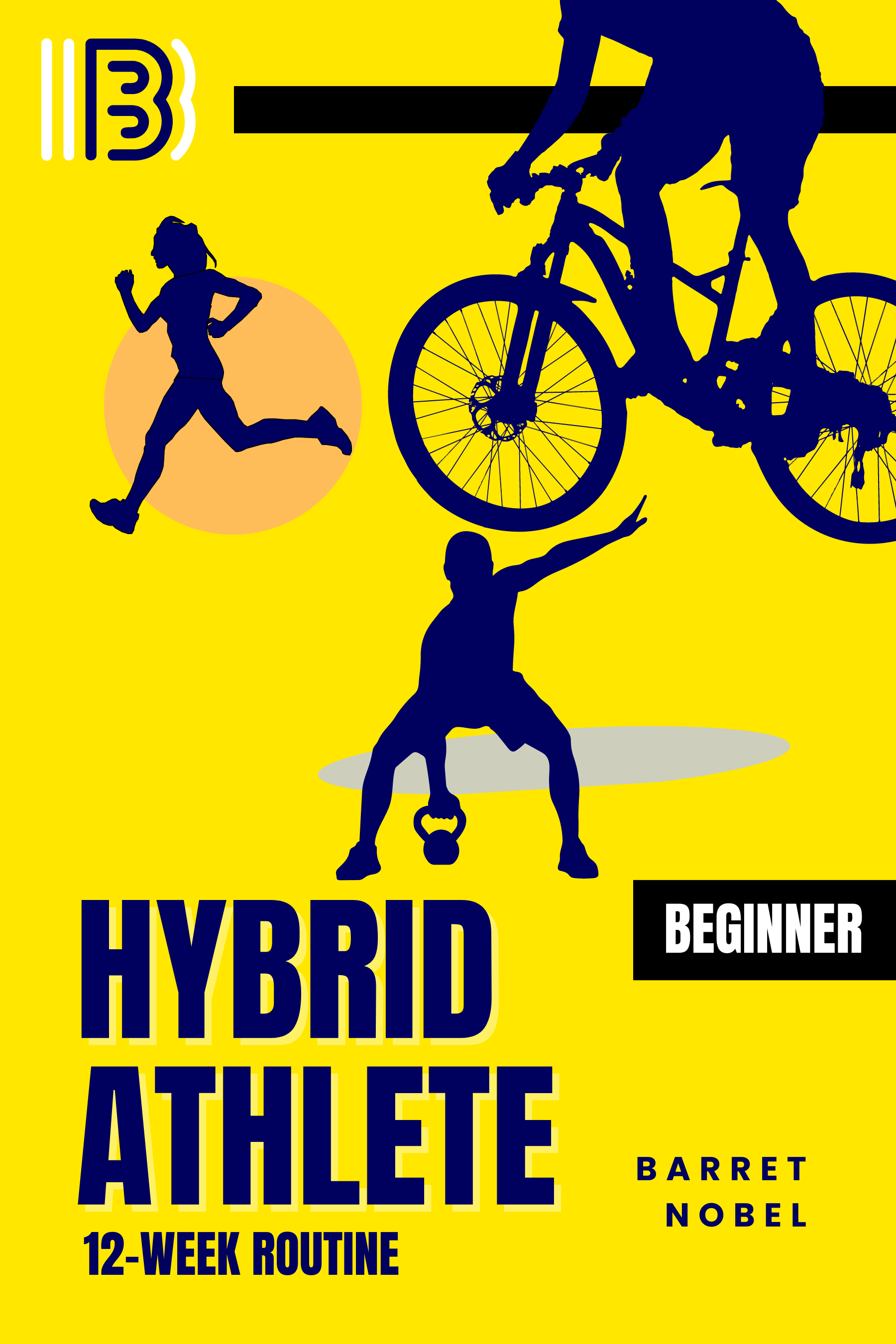Training Framework for Hybrid Athletes: Run, Lift, and Grow
This training framework is for hybrid athletes looking to improve their fitness and performance through running, lifting, and growing

The world of fitness has evolved significantly in recent years. More and more athletes are recognizing the benefits of training for multiple disciplines. Enter the hybrid athlete—a versatile competitor who excels in both strength and endurance sports. This article will provide a comprehensive training framework to help you run, lift, and grow as a hybrid athlete.
Do Hard Things*: Achieve fitness goals with Fit for Life, a minimalist log book for men and women. Track progress and set monthly goals with expert design.
LMNT: Stay Salty! A tasty electrolyte drink mix that is formulated to help anyone with their electrolyte needs and is perfectly suited to folks fasting or following low-carb, whole-food diets
Nurecover: Leaders in cold therapy. A simple effective way to enjoy cold water therapy LITERALLY anywhere from your; House, Patio, Garden, Balcony, Work, Holiday, Apartment.
SIMPLY8*: a new vegetarian supplement formula without any corn syrup or gelatin. Our tapioca and pectin-based vitamins are designed to make self-care simple, healthy, and yummy. Use codesimply8off10
yourcompany.com: Interested in sponsoring this blog? 📩 → blogSponsor@hybridathletepro.com
Benefits of Being a Hybrid Athlete
Becoming a hybrid athlete comes with a variety of benefits. Let's explore a few of the key advantages:
Improved Performance in Multiple Sports
Becoming a hybrid athlete and incorporating both strength and endurance training into your routine can significantly improve your performance in multiple sports. By focusing on various aspects of athleticism, you'll develop a wide range of skills that can be applied to different disciplines. Here are some ways in which hybrid training can lead to improved performance:
- Versatility: Hybrid athletes are highly adaptable, which enables them to excel in different sports environments. By developing a well-rounded set of athletic skills, you'll be better equipped to handle the unique challenges of various sports, from the explosive power needed for sprinting to the muscular endurance required for long-distance running.
- Increased Power Output: Strength training can lead to increased power output, which is essential for improved performance in many sports. For example, a strong lower body can result in faster sprint times, higher jumps, and more powerful kicks in sports like soccer or martial arts.
- Greater Endurance: Endurance training, such as running or cycling, improves your cardiovascular fitness and allows you to maintain a higher level of intensity for longer periods. This can be especially beneficial in sports that require sustained effort, like soccer, basketball, or long-distance running.
- Enhanced Agility and Speed: Hybrid training often includes exercises that improve agility and speed, such as plyometrics and functional training. These exercises can help you change directions quickly, react to unexpected movements, and accelerate rapidly—all critical components for success in sports like basketball, soccer, and tennis.
- Improved Mental Toughness: Training for multiple sports disciplines requires dedication, discipline, and mental fortitude. As a hybrid athlete, you'll develop the mental toughness needed to push through challenging workouts and persevere in high-pressure competition situations.
- Better Recovery and Injury Prevention: A balanced training approach can lead to improved recovery and reduced risk of injury. By developing a strong foundation in both strength and endurance, you'll be less prone to muscle imbalances and overuse injuries that can occur when focusing on a single discipline. This can result in more consistent performance and a longer, healthier athletic career.
Increased Overall Fitness
One of the most significant benefits of becoming a hybrid athlete is the increased overall fitness that comes with training in both strength and endurance disciplines. By engaging in a well-rounded training program, you can expect to see improvements in various aspects of your physical fitness, such as cardiovascular health, muscle mass, flexibility, and functional abilities. Here's a closer look at how hybrid training can lead to increased overall fitness:
- Cardiovascular Health: Engaging in regular endurance training, such as running, cycling, or swimming, can significantly improve your cardiovascular health. As your heart and lungs become more efficient, your resting heart rate may decrease, and your ability to transport oxygen throughout your body can improve. This can lead to better performance in daily activities and a reduced risk of cardiovascular diseases.
- Muscle Mass and Strength: Strength training is essential for building muscle mass and increasing overall strength. By incorporating compound exercises like squats, deadlifts, and bench presses, you'll target multiple muscle groups, promoting balanced muscle growth and improved functional strength. Increased muscle mass can also contribute to a higher resting metabolic rate, which can aid in weight management.
- Functional Abilities: Functional training exercises, such as kettlebell swings, box jumps, and sled pushes, are designed to mimic movements you might perform in everyday life or sports. By incorporating functional training into your hybrid athlete program, you'll develop the strength, stability, and mobility needed to perform daily tasks more efficiently and reduce the risk of injury.
- Flexibility and Mobility: A well-rounded hybrid training program should include stretching and mobility exercises to help maintain and improve flexibility. Increased flexibility can improve your range of motion, reduce muscle imbalances, and decrease the risk of injury. Better mobility also contributes to improved performance in various sports and daily activities.
- Body Composition: Training as a hybrid athlete can lead to positive changes in body composition. By combining strength and endurance workouts, you can build lean muscle mass while also burning fat. This can result in a more toned and athletic physique, improved self-esteem, and better overall health.
- Mental Health Benefits: Engaging in regular physical activity has been shown to have numerous mental health benefits, such as reduced stress, improved mood, and better cognitive function. By participating in a variety of strength and endurance activities, hybrid athletes can enjoy these mental health benefits while continually challenging themselves and staying engaged in their training.
Injury Prevention
A significant advantage of adopting a hybrid athlete training approach is the potential for injury prevention. By focusing on various aspects of fitness, including strength, endurance, mobility, and flexibility, you can reduce the risk of common injuries associated with overuse or muscle imbalances. Here are some ways in which hybrid training can contribute to injury prevention:
- Balanced Muscle Development: Focusing exclusively on one type of training, such as endurance or strength, can lead to muscle imbalances and overuse injuries. Hybrid training promotes balanced muscle development by incorporating a variety of exercises that target different muscle groups. This can help prevent imbalances, reduce the risk of injury, and contribute to improved overall athleticism.
- Reduced Overuse Injuries: Engaging in a single sport or discipline can increase the risk of overuse injuries due to repetitive stress on specific muscles and joints. By incorporating multiple training modalities, hybrid athletes can distribute stress more evenly across their bodies, reducing the likelihood of overuse injuries and allowing for more consistent training.
- Improved Mobility and Flexibility: Poor mobility and flexibility can contribute to a higher risk of injury, as they can limit your range of motion and result in compensatory movement patterns. Hybrid training often includes exercises that promote mobility and flexibility, helping you maintain proper form during workouts and reducing the risk of injuries associated with poor movement patterns.
- Functional Strength: Functional training exercises, which mimic the movements you perform in daily life or sports, can help improve your overall functional strength. By developing the muscles and movement patterns needed for real-life activities, you can reduce the likelihood of injuries caused by muscle imbalances or inadequate strength during sports or daily tasks.
- Increased Body Awareness: Hybrid training requires you to engage in various exercises and activities, which can help you develop a heightened sense of body awareness. This increased awareness can lead to better movement patterns, improved form during workouts, and ultimately, a reduced risk of injury.
- Periodization and Recovery: Periodization, or organizing your training into distinct phases or cycles, is a key principle of hybrid athlete training. This approach allows for adequate recovery time, reducing the risk of overtraining and injury. Incorporating rest days and active recovery sessions, such as yoga or foam rolling, can also help prevent injuries by promoting muscle recovery and maintaining flexibility.
Building a Hybrid Athlete Training Program
Designing a hybrid athlete training program requires careful planning and consideration. Here are three key principles to keep in mind:
- Periodization: Periodization involves organizing your training into distinct phases or cycles. This allows you to focus on different aspects of your fitness while ensuring adequate recovery time.
- Balancing Strength and Endurance Training: To become a successful hybrid athlete, you'll need to strike a balance between strength and endurance workouts. This might include incorporating interval training, tempo runs, heavy lifting sessions, and functional training exercises into your routine.
- Incorporating Mobility and Flexibility: Don't forget to work on your mobility and flexibility. These are crucial components of any well-rounded training program and will help you maintain proper form and prevent injuries.
Key Components of Hybrid Athlete Training
Now that we've covered the foundational principles of hybrid athlete training, let's dive into the key components:
Running Training
Incorporating running training into your hybrid athlete program is essential for developing cardiovascular endurance and improving overall athleticism. Running workouts can vary in intensity and duration, providing a versatile way to challenge your body and increase your fitness level. When designing your running training plan, consider including a mix of interval workouts, tempo runs, and long, slow distance runs. Interval workouts involve alternating between periods of high-intensity running and recovery, effectively improving your aerobic and anaerobic capacity. Tempo runs, on the other hand, are performed at a comfortably hard pace for a sustained duration, helping you develop the ability to maintain a faster pace over longer distances. Long, slow distance runs are crucial for building your aerobic base and enhancing your body's ability to utilize fat as fuel during prolonged exercise. By incorporating a variety of running workouts into your hybrid athlete training program, you'll effectively develop cardiovascular endurance, improve running efficiency, and increase your overall fitness, contributing to better performance in both endurance and strength-based sports.

Strength Training
Strength training is a critical component of a hybrid athlete's training program, as it helps to build muscle mass, increase overall strength, and enhance athletic performance in various sports. To effectively incorporate strength training into your routine, focus on compound exercises that target multiple muscle groups simultaneously, such as squats, deadlifts, bench presses, and rows. These exercises not only promote balanced muscle development, but also improve functional strength by mimicking the movements you might perform in daily life or sports. In addition to compound exercises, include accessory movements that target specific muscles, like bicep curls, tricep extensions, or calf raises, to further enhance your muscular development and address any weaknesses. To maximize your strength gains, incorporate periodization and progressive overload, gradually increasing the weight, volume, or intensity of your workouts over time. This approach ensures that your muscles are consistently challenged and helps to prevent plateaus in your progress. By integrating strength training into your hybrid athlete program, you'll experience increased power output, improved muscular endurance, and a more balanced, injury-resistant physique.
Functional Training
Functional training is an essential aspect of a hybrid athlete's training regimen, as it aims to improve the strength, stability, and mobility needed to perform daily tasks and excel in various sports. These exercises typically involve multiple joints and muscle groups, simulating real-life movements and promoting overall functional fitness. Examples of functional training exercises include kettlebell swings, box jumps, farmer's walks, and medicine ball throws. By incorporating functional training into your routine, you'll develop better core stability, coordination, balance, and movement efficiency. Additionally, functional training can help prevent injuries by addressing muscle imbalances and improving joint mobility. One of the most significant benefits of functional training is its transferability to sports performance, as the skills and strength developed through these exercises can directly enhance your abilities in various athletic disciplines. By including functional training as part of your hybrid athlete program, you'll become a more well-rounded and adaptable athlete, ready to tackle any challenge in both sports and daily life.
Nutrition and Recovery
Proper nutrition and recovery play a vital role in the success of a hybrid athlete, as they provide the necessary support for the body to adapt and grow stronger from diverse training demands. Consuming a well-balanced diet, rich in carbohydrates, proteins, and healthy fats, ensures that your body has the energy and nutrients it needs for optimal performance and recovery. Carbohydrates are essential for fueling endurance workouts and replenishing muscle glycogen stores, while proteins support muscle repair and growth after strength training sessions. Healthy fats, such as those found in avocados, nuts, and fish, provide a long-lasting energy source and support overall health.
Hydration is another crucial aspect of nutrition, as maintaining proper fluid balance helps to regulate body temperature, support muscle function, and prevent dehydration-related performance issues. Make sure to drink water regularly throughout the day and replenish fluids lost during workouts.
Recovery is equally important for hybrid athletes, as it allows the body to repair damaged muscle tissue, replenish energy stores, and adapt to the stresses imposed by diverse training modalities. Incorporating rest days and active recovery activities, like yoga, swimming, or light cycling, can help to promote muscle recovery and maintain flexibility. Additionally, focusing on proper sleep hygiene is vital, as sleep is the prime time for the body to repair and regenerate. By prioritizing nutrition and recovery, you'll create a supportive environment for your body to thrive, leading to more effective training, better performance, and a reduced risk of injury.
Sample Hybrid Athlete Training Schedule
To give you an idea of how to structure your training, here's a sample hybrid athlete training schedule:
- Monday: Strength training (Upper body focus) + 30-minute easy run
- Tuesday: Interval running workout
- Wednesday: Strength training (Lower body focus) + mobility work
- Thursday: Tempo run
- Friday: Rest day or active recovery
- Saturday: Functional training workout
- Sunday: Long, slow distance run
Remember to adjust your training schedule based on your individual needs and goals, and consult with a coach or fitness professional if you need guidance.

Hybrid Athlete 12-Week Routine | Beginner
Curious what all this hybrid athlete hype is about? This book provides a 12-week workout routine, but also information on the importance of being a well-rounded athlete. By incorporating a balance of strength and endurance into your training, you'll be able to reduce your risk of injury, improve your overall health, and reach your goals!
Becoming a hybrid athlete can provide numerous benefits, from improved performance in multiple sports to increased overall fitness and injury prevention. By designing a well-rounded training program that incorporates periodization, balances strength and endurance training, and focuses on key components like running, strength training, functional training, and nutrition, you'll be well on your way to becoming a successful hybrid athlete. Remember to be patient, stay consistent, and enjoy the journey of transforming yourself into a versatile and powerful competitor.
FAQs
What is a hybrid athlete?
A hybrid athlete is someone who trains and competes in both strength and endurance sports, excelling in multiple disciplines by developing well-rounded athletic abilities.
Why should I consider becoming a hybrid athlete?
Becoming a hybrid athlete can lead to improved performance in multiple sports, increased overall fitness, and a reduced risk of injury due to a balanced approach to training.
How can I balance strength and endurance training in my program?
To balance strength and endurance training, incorporate a mix of interval training, tempo runs, long distance runs, heavy lifting sessions, and functional training exercises into your routine.
What are some essential components of a hybrid athlete training program?
Key components of a hybrid athlete training program include running training, strength training, functional training, and a focus on proper nutrition and recovery.
How can I create a personalized hybrid athlete training schedule?
To create a personalized training schedule, consider your individual goals, preferences, and available time. Adjust the sample training schedule provided in this article to suit your needs, and consult with a coach or fitness professional for guidance.
If you're a regular ol' hybrid athlete, you might fall in love with my Tubes channel 👇
https://www.youtube.com/@BarretNobelFitness
It is not only about fitness, it is about life in general. I try to inspire regular people. Check it and subscribe to get notified when new vids come out 🤙
Thanks for reading 🙏!
Don't forget to follow me on our social media for more tips, inspiration and community support! You can find me on Instagram, Facebook, Twitter and TikTok under the handle @BarretNobelFit.
See you in the next post!


